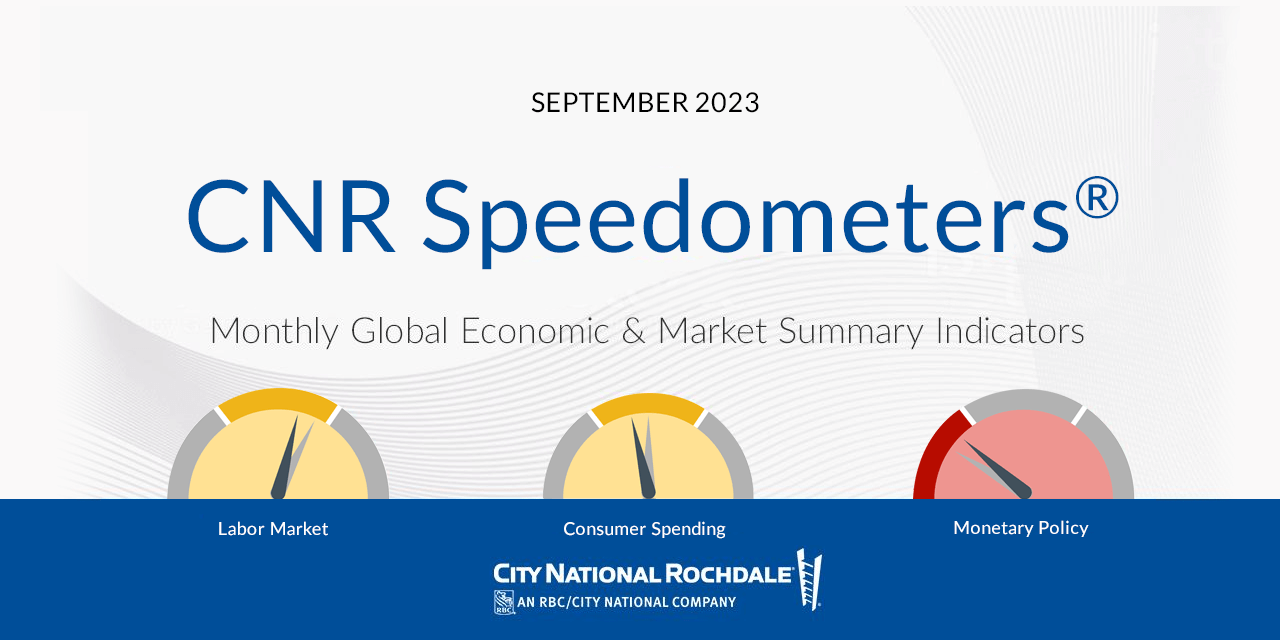
CNR Speedometers®
September 2023
Forward-Looking Six to Nine Months
TRANSCRIPT
The key takeaway this month is that, while there has been recent good news in the battle against inflation given cooling conditions in the labor markets, it's too soon to signal the “all clear” for financial markets, and there's no change to our higher-for-longer thesis or expectations for a mild recession in coming months and quarters — a time note that remains elusive.
First Dial Update: 0:37 — Let's dive in, starting with the Labor Market dial, where we're tilting it modestly to the left while keeping it in the yellow zone. Both the Job Openings and Labor Turnover Survey (JOLTS) and the payroll reports indicate labor markets are cooling, and the normalization process is underway.
The number of job openings has continued the downward trend from April's level of 10.3 million to approximately 8.8 million in July; or latterly, the number of job openings per person seeking employment fell to 1.5 times, from a peak of over 2.
The payroll report also showed signs of normalization. Nonfarm payrolls rose by a solid 180,000 in August, led by increases in healthcare, leisure and construction.
However, there were downward revisions for June and July by 80,000 and 30,000, respectively. These downward revisions took the three-month average down around 150,000, a level modestly below pre-pandemic levels, and that's a good thing.
Lastly, the quits rate and the share of consumers saying jobs are plentiful declined. In some cases, these reports paint an encouraging picture that supply-demand balances in the labor markets are improving, and is a positive development in the battle against inflation.
Second Dial Update: 1:58 — We're also tweaking the Consumer Spending dial modestly to the left, keeping it in the yellow zone. While consumers are continuing to spend — especially on vacations, restaurants and services — the pace should moderate going forward, partially due to the cooling and labor markets.
Additionally, our contacts with companies indicate that consumers are becoming more cautious in their spending, are spending more on necessities and are trading down for less expensive goods and services.
Other modest headwinds we’re anticipating in the next six to nine months include a continued decline in excess savings; an increase in student loan payments; and the fact that consumers are going to have to pay off these “high vacation” and “back-to-school spending” credit card bills that they incurred in these last several months.
On the positive side, because the average hourly earnings of 4.3% remain nicely above the inflation headline of 3.3%, and the wealth effect of higher stock prices and higher home prices remain intact, we continue to believe the overall backdrop for consumers supports our mild recession forecast, and only a modest tweak to the dial is called for.
Third Dial Update: 3:11 — The last change we're making is to our Monetary Policy dial, which we're keeping in the red zone, but tilting the dial a bit to the right. While the battle against inflation is far from over, the slowdown that is occurring in the labor market should be enough to prevent policymakers from raising rates at the September Federal Open Market Committee (FOMC) meeting.
As such, we're likely at peak levels of the Federal Reserve funds rate, and hence, the modest adjustment in the dial.
Though, with the core inflation and average hourly earnings in the 4.3% range, and the supercore inflation in the 4.7% range, the Fed is likely to keep rates higher for longer, so that dial remains red.
All in all, while there's been good news in the battle against inflation due to cooling conditions in the labor market, there's no change to our higher-for-longer thesis or our expectations for a mild recession in coming months and quarters.



